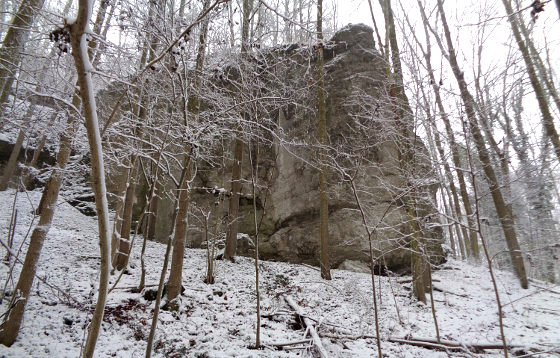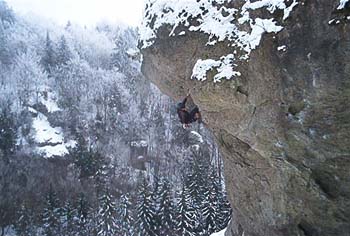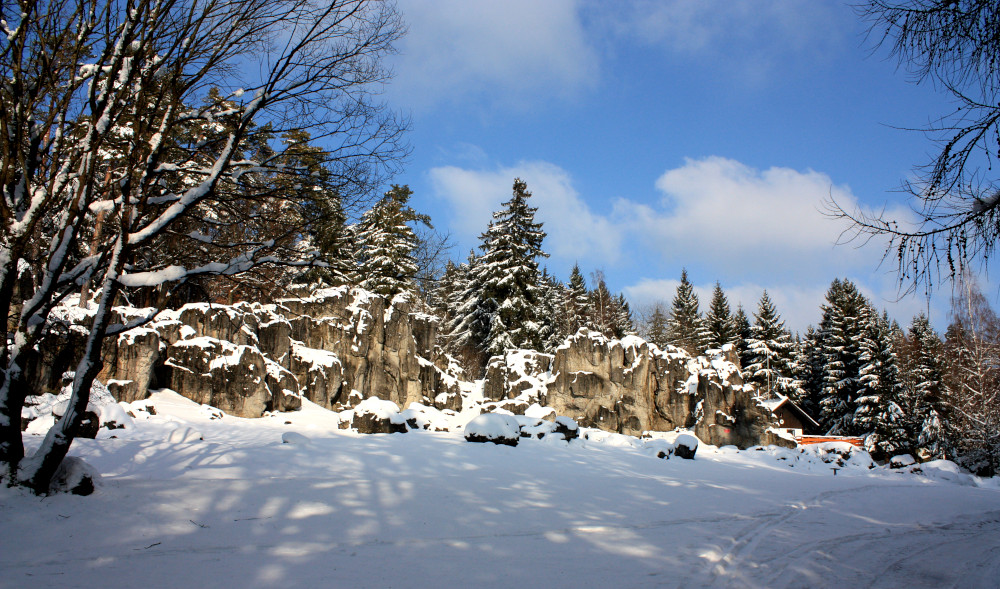Table of Contents
We all know the problem, summer season is way too short for most of us living in northern climate zones. And when September ends, days get cooler and you might be able to sneak in a good session in October, but wait until November and thats over. Rain and cold are sneaking up on you, making belaying and climbing a challenge. Everyone who climbed outside with temperatures below the 40s can probably agree with me, climbing in cold weather is tough.
Add some wind and you’ve got a recipe for numb hands and feet, plus the cold rock doesn’t make it any easier.
But the cold has some nice side effects too, friction on some rocks becomes better when temperatures are cold. And there are virtually zero crowds – this is especially true if you live in places with lots of climbing routes on relatively small area, which tend to be overcrowded in summer.
But how do you stay warm and comfortable, or at least keep cold to a bearable level and stay safe, when the days get shorter and the temperatures drop?
Get ready for a load of information, and while some of these tips may sound funny or odd, they are field proven and work.
Combine these two approaches for staying warm when climbing in cold weather
A) Body heat and insulation: Anything clothing and exercise related falls into this category. Eating and warming up as well. This is the base of staying warm.
B) External heat sources: Warmers, hot Liquids and exposure to Sun falls under this category. These are optional, and while they can make a difference, they won’t work too well if you neglect A.
1. Layering
Layering is key. Air insulates, and the best way to keep warm air around your core is to have multiple layers of clothes. You need 3 layers to stay warm, a base layer a mid layer and a nice warm outer shell like a down jacket.
As your head loses most of the heat you should also always wear a beanie, headband or hat. And sometimes a hood on top of the beanie works wonders to keep heat from evaporating from your neck – a spot which looses lots of heat when you’re exercising outside.
Warm socks are also a no-brainer. How to deal with tight climbing shoes? Get a comfortable pair one size bigger for the cold time of the year and wear your socks, it makes a ton of difference. Trust me,, its better to have little less feeling due to socks than numb toes from freezing.
Another layer most forget is the mid layer, aka underpants. It can be leggings or a pantyhose but what i prefer are leg warmers or knee pads. It’s an incredible difference when your legs stay warm as they are such a big organ and tend to lose more heat than you think. Don’t forget to put on some nice puffy pants once you start belaying – that way you stay warm while inactive.
Your number one priority should be adequate clothing, as it keeps not only your core warm but also your hands and feet. Cold hands and feet are usually a sign of your body trying to increase your core temperature by reducing blood flow to the extremities as a counter measure.

2. Add and remove layers to avoid sweating
Avoiding to sweat is key to staying warm. So make sure to get rid of too much clothes while you actually climb to avoid soaking in sweat, and put on another extra layer while you’re belaying and staying still. Belaying is your enemy when climbing in cold weather, and this is even worse if there is wind blowing. So make sure to put on some extra layers when you’re belaying. The principle of staying dry in order to stay warm is old outdoor knowledge, and it comes down to basic thermodynamics. When your body is wet, heat transport is increased and this leads to rapid cooling. And by the way, that’s why you get cold so fast when you’re swimming in cold water.
3. Chemical Warmer Packs
If things get really freezing there is a nice trick i use: I heat my chalk bag with chemical warmers. You can get them at any supply store or even online at amazon. Just throw one in you chalk bag. Frozen rock makes your fingers cold really quick, and this way you are sure that your cold and numb fingers get a nice breeze of warm and comfy chalk every time you dunk in. This is very important for the first routes, as numb fingers when beginning a route can stop any sending in the tracks.
They sell them for your body too, and if you’re sensitive to cold get one warmer pack for your chest too. A warm chest means warm blood flow and will definitely keep your feet and hands from becoming numb fast. But be careful to leave a layer of clothes between the warmer pack and your skin to avoid burns.
4. Calisthenics
Warm up for at least 10 minutes with an extra layer of cloth, until you just start to break sweat.
The penguin exercise is great for warming up, as you rub your sides of the torso with your arms really quick, increasing flow of blood and increasing heat.
Don’t just focus on your hands – cold hands BEFORE climbing usually mean your body temperature as whole is too low. It’s okay if your hands get cold from touching the rock while on the climb, but you should always feel warm and comfortable beforehand. Never start a climb with numb and cold hands – instead do jumping jacks and some push-ups to get the blood flowing.
And then shed the extra layer of clothing before you start.
5.Numb out early to have better circulation later on
If it’s frozen solid outside, you will quickly notice that your fingers numb at out at some point no matter what you do to avoid it. And when they warm up they will hurt like crazy, this is called screaming barfies. It’s cause by warm blood entering your fingers, making the tissue swell up and this puts pressure on the nerves. This hurts like a *****, but it’s good as it means you are regaining temperature and bloodflow, and it usually happens only once in the beginning.
It might make sense to try and get this sensation out of they way as early as possible because when it’s over you will have the benefit of good blodflow and further numbing will feel less painful when reheating.
6. Climb and belay in the sun
Wintersun has not much energy compared to the summersun, but it’s still a good idea to stick with the sun exposed routes in winter. You will be pleasantly surprised how much of a difference it makes if you’re belaying in shade or in sunlight, even in winter. A nice side effect: You can focus on the your project routes that are way to hot during summer after all. And the rock is warming up in the sun too, making it easier to avoid finger numbing from cold rock.
7. Keep the right temperature all the time
This is close related to 2. Like said before, moisture from sweating should be something you avoid like the plague. So better strip the outer layers when the approach to the route includes a steep ascent or some brushes to find your way through. If you cannot avoid sweating, at least bring a second shirt or layer of choice and change into it when you arrive. But don’t change to soon, or you might “aftermath” sweat into the new layer – it takes some time after exercise until your body actually stops perspirating.
8. Insulated Clothing
Toss your summer clothes when climbing in cold weather. It’s winter time and you need a warm down jacket. Stick with a down jacket( at least 600 fill power) and a hood when its below 40 degree. A hood keeps your neck from losing heat, and a down jacket is nice and toasty. If it’s raining you can either get a synthetic down jacket or cover your down jacket with a rain cover. You definitely need to keep down dry, as they lose their insulating effect when wet. Gloves can be a nice addition too, especially when the approach is long.
9. Drink hot tea, cocoa or coffee
Bring a gas stove and make a soup, tea or coffee if possible. Hot cocoa is nice too, and the added sugar and fat give you some calories to burn and stay warm. It’s also a nice psychological effect: A warm gas stove, with a cozy flame is always a comforting sight in the crisp cold of winter. Don’t overdo it with the caffeine by the way, as it acts as a natural blood flow inhibitor, and caffeine jitters can be especially annoying when lead climbing, as most people are prone to adrenaline rushes when leading anyway.
10. Eat, Eat, Eat
If it’s cold your body needs more energy. If you spend hour after hour outside, you must feed your body enough fuel, so bring plenty of good snacks like dry nuts&fruits, apples and bananas and maybe some energy bars or even a sandwich.
A good breakfast with hearty foot is also something you can do: Avocado, nuts, peanut butter eggs and bacon, they all work well. Just make sure you don’t overfill and become sleepy before you go climbing.
Nice side effect: There is no nicer way to eat than outside, in a cold sunny forest or natural scenery with your best friends while having a hot cup of tea.
12. Instead of taking turns each route, climb longer and then take turns
Instead of climbing and belaying and taking turns, you can consider to block your climbing and belaying time. That way you avoid to warm um after getting cold in loops, but rather warm up once, finish all your climbs and then belay. This way you minimize needed resting.

13. Make a fire, but be careful with the rock
If it’S really cold, make a fire. It’s a great way to warm up between climbs and is a cozy sight at any rockwall during winter time. But be careful, if it’s way below 30 degree, try to be super careful with the rock. The problem is: Cold rock is more brittle than warm rock, so if it has been snowing for some days you should probably avoid having a fire close to the wall as this destroys the climb forever. NEVER use torches or tarps to keep the rock warm or dry, as it ruins the route forever. Instead rather head to the climbing gym and work on some power moves.
14. Keep gloves on when belaying
Exposing your hands to cold wind and rope is a surefire way to numb out. So invest some money in good insulated leather gloves, not only does it keep your hands warm, but they also look good and protect from rope burn.
15. Rest while climbing with arms down the side
While sending it, make sure to take rests every once in a while. Let your arms hang down to the side of the body when resting, as this makes blood flow easier. The worst position is arms above head, as this actually forces blood to flow out of them.
16. Once you go numb, use your eyes
In a situations where your appendages go numb make it a habit to visually confirm that your placement of feet is good and spot on. Just because you cannot feel it, does not mean it’s not a good position for your feet!
17. Use your arm pits and breath when resting to warm up your hands and fingers
Just stick your hands under your armpits when resting, they will warm up this way. Another trick when climbing in cold weather is to form a cave with your hands and breath into them for 3-4 breaths, this gives them a little short burst of heat and feeling if they start to go numb. I’ve been doing this while surfing for years and it worked super great for climbing too.
18. Keep your climbing shoes in front of your belly, just on layer above skin while belaying
By keeping your pair of climbing shoes close to your body they stay nice and warm, so when it’s your turn to climb your shoes are soft and warm and ready to rock. And warm shoes will keep your feet warmer too. Just make sure you don’t put the directly to your skin as this will cool your skin down when the shoes are cold.
19. Follow this preparation before and while climbing
This is my goto recipe, and if you follow this approach you will not become cold.
1. Before you start driving, open up two hand warmers so they’ll be warm by the time you get to the parking.
2. Once you park, put the hand warmers in your climbing shoes and put your climbing shoes underneath all your layers, right up against your belly.
3. Tuck all your layers into your pants and then hike out to the rock or boulders. 4. Do 50 jumping jacks.
5. Put the shoes on one at a time, and blow hot air into them, put ’em on as fast as you can to keep the heat inside.
6. Fill a beanie with 4 hand warmers, in between attempts stuff your hands and feet into the beanie.
20. Keep some hand warmers in your shoes
Just keep hand warmers in your shoes, one per shoe. This will keep the shoes warm and soft. As the hand warmers stay warm for hours, this strategy works super well even when outside for hours on end.
Conclusion
That’s it guys. These 20 methods work super good for staying warm when climbing in cold weather. Definitely check your local mountain supply store for discounts on down jackets and winter gloves.
But with these tips you will probably never have to suffer excess cold when climbing outside during the winter months or in cold weather. Here are some more tips for climbing endurance and my article of the differences between indoor and outdoor bouldering..
Stay warm and fuzzy!

